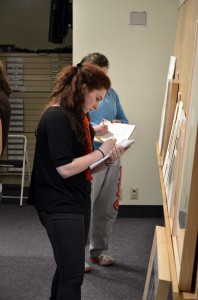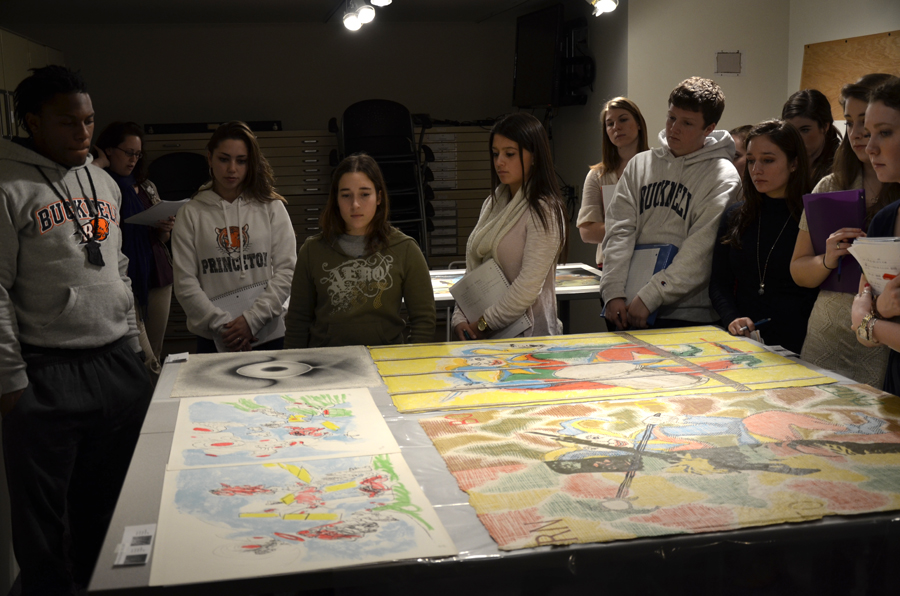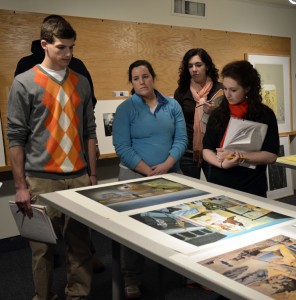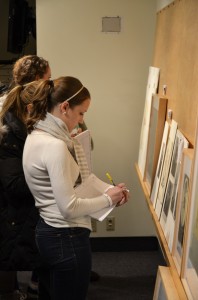(The following is a guest post written by Assistant Professor of Spanish Collin McKinney. Professor McKinney has been a friend of the Samek for years and he brings a class to view works from our Museum Collection each semester. One of the resources the Samek has to offer students, faculty and the community at large is our Collection Study Room, located on the third floor of the Langone Center just outside the gallery doors. I greatly enjoy when Professor McKinney’s class comes to use the Collection Study Room because it provides us an opportunity to merge our areas of expertise together into a lecture “of a different color”: I can talk about the artists, movements, mediums and materials while Professor McKinney can speak to the social & cultural movements where & when the artists were working.)
I take all of my students to the Samek. It doesn’t matter whether I’m teaching a language course, or a course on Spanish civilization and culture, it is one of the first things I put on my syllabus each semester. There are four principle reasons that I include this activity in my curriculum.
The museum experience:
Every classroom that I teach in is equipped with a computer and projector. Often I can, and do, find images in online databases and project these onto the screen so that we can discuss them as a class. So, why bother going to the gallery? Maybe I’m old school, but I think that there is value in seeing an artwork in person. When our interaction with the work is unmediated by technology, the colors, the size, and the texture of the piece is exactly as the artist intended. This intimacy with art is something that I want my students to experience.
From visual to verbal:
It is not easy to convert a visual image into a linguistic piece. Doing it  in foreign language is harder still. After our visit to the Samek students choose one of the artworks and write an essay. After describing the artwork, students then have to interpret it. As they do, the art becomes not just something interesting to look at, but a vehicle for critical thinking.
in foreign language is harder still. After our visit to the Samek students choose one of the artworks and write an essay. After describing the artwork, students then have to interpret it. As they do, the art becomes not just something interesting to look at, but a vehicle for critical thinking.
Seeing history:
Why study art? This is a question that we discuss in class often. Among the many possible answers to the question is the fact that art reflects and critiques the culture in which it was produced. The intellectual climate of a period permeates every work of art, and a trip to the Samek is a history/philosophy/political-science course all rolled up in one.
A matter of taste:
Ultimately, the way we interact with a work of art is personal. I happen to love Goya’s Black Paintings, but I know that some of my students do not like them one bit. As students are exposed to a variety of styles and themes, they discover their own tastes and are able to explore differing conceptions of beauty.
We are lucky to have such a rich and accessible collection of art at Bucknell, and yet so many students don’t even know about it. Every time I take a group to the Samek Gallery, I inevitably hear the following confession from one or two students, “I didn’t even know this was here.” I like to think that my students are better off for having ventured up to the top floor of the LC.
Professor Collin McKinney, Spanish




